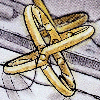| View previous topic :: View next topic |
| Author |
Message |
|
|
Lokarunith
 Joined: 30 Aug 2011
Joined: 30 Aug 2011
Posts: 30
Location: Portugal
|
 Posted: Fri Apr 08, 2016 10:42 pm Posted: Fri Apr 08, 2016 10:42 pm
|
 |
|
|
Hi, I've been collecting manga for a long time, I speak portuguese (native), english and spanish and I have in my collection books from 4 different countries (Portugal, Brazil, Spain and USA) and I have seen how manga is published in France as well. If you speak more than one language it could be very worth it to import manga from another country.
I want to share with you some of the main differences I found comparing manga from each country as I think it's very useful for collecting purposes or just curiosity.
USA
Std. paper qlty: B- (slightly grey recycled textured paper with tendency for yellowing over time)
Std. printing qlty: A- (overall very good but many books may get darker acording to the state of conservation)
Std. Size: Sligthly oversized (19x12,7 cm)
Dust jacket: No
Variety of titles and genres: A-
Notes: To compensate the somewhat cheap regular manga edition there's a lot of quality special editions and some publishers use better quality paper.
Spain
Std. Paper qlty: A+ (shiny white plain paper with no transparency that doesn't get yellow easily)
Std. Printing qlty: A (Very good)
Std. Size: Same as original version (between 13x18 cm and 11,5x17 cm)
Dust jacket: Yes
Variety of titles and genres: B
Notes: Best standards for manga quality that I have ever seen, all publishers use almost 100% of the time excellent paper nevertheless some less experient publishers may occasionaly not do well on the printing/image resolution department.
France
Std. Paper qlty: B (slightly grey plain paper, with minimal transparency with tendency for yellowing over time)
Std. Printing qlty: A (everything fine)
Std. Size: ?? (same size as japanese version I think)
Dust jacket: Yes
Variety of titles and genres: A+
Notes: My knowledge of manga publishing in france is limited, but I know It stands out for it's amazing variety and the massive size of it's industry.
Brazil
Std. Paper qlty: Inconsistent (D to A) (Paper is plain and can be completly white or grayish acording to the publisher, it usualy suffers from transparencies, to what degree depends on the specific title)
Std. Printing qlty: A (It's ok so far what I've seen)
Std. Size: Very oversized (20,5x13,5 cm)
Dust jacket: No
Variety of titles and genres: D+
Notes: Paper thickness is very inconsistent and changes from series to series. A standard brazilian manga edition might be better than or worse but fortunately quality is getting better with time.
Portugal
Std. Paper qlty: C (Plain white paper with transparency issues)
Std. Printing qlty: B
Std. Size: Slightly oversized (same as US)
Dust jacket: No
Variety of titles and genres: F
Notes: In Portugal we mostly import manga from the US instead of translating them as most of the population is already fluent in english. Portuguese manga mimics the US editions but are of overall lower quality.
Last edited by Lokarunith on Mon Jun 06, 2016 2:39 pm; edited 1 time in total
|
| Back to top |
|
|
|
lys
 Joined: 24 Jun 2004
Joined: 24 Jun 2004
Posts: 1008
Location: mitten-state
|
 Posted: Sat Apr 09, 2016 6:43 pm Posted: Sat Apr 09, 2016 6:43 pm
|
 |
|
|
Thanks for sharing your observations! It is pretty interesting to see how different publishing markets handle something like manga. I'm curious how the differences in paper quality are (or aren't) reflected in the price, too. Are French and Spanish editions more expensive than US editions (base price, not counting import/shipping costs)?
Paper quality doesn't bother me unless it's quite bad. The Japanese books I've got don't seem much different from my US books. The only perfectly-white pages I have in reach on my desk are the (JP) Fruits Basket collector's edition rerelease; otherwise the pages all tend to have an off-white colour and slightly rougher texture, in either language. The printing quality seems identical in the books I just checked (a side-by-side comparison of the same page of orange v1 from Futabasha and SevenSeas). One factor that may cause "darker" printing is that at one time a lot more US publishers (and I assume FR, SP, etc) had to scan the artwork from the printed Japanese books, while now it's much more common to receive files directly from the JP publisher of the exact same quality they send to their own printers. So there is no danger of losing faint details or having to over-darken the image to get all the lineart and screentone, as there is when scanning an already-printed page.
I am sometimes jealous of all the interesting titles France gets, but my Japanese reading skills are better than my French, so when I must read something that isn't yet in my native language, I just import the original :)
|
| Back to top |
|
|
|
Alan45
 Village Elder
 Joined: 25 Aug 2010
Joined: 25 Aug 2010
Posts: 9840
Location: Virginia
|
 Posted: Sun Apr 10, 2016 8:38 am Posted: Sun Apr 10, 2016 8:38 am
|
 |
|
|
With regard to paper quality in the US, I would have to disagree. I don't think you can evaluate all US publishers together. Paper quality varies noticeably from one publisher to another. Also the quality can vary a great deal from a specific publisher depending on the period in question or the title involved. For an example compare Dark Horse's recently completed Oh My Goddess! singles to the CLAMP omnibus volumes or even the new omnibus versions of the same title or the old flipped version of the early volumes.
Also, concerning trim size, I think it would be more accurate to refer to "common" sizes rather than "standard" as there is no one setting any standards involved. Indeed, both in the US and Japan manga comes in multiple sizes. I have manga volumes in four or five different sizes from Japan. It seems to vary by publisher and edition.
Manga in the US comes in two general sizes. 19cm by 12.5cm and 21cm by 14.5cm. Enough of the larger size is currently in print that this can be called a common size in the US. The smaller size while most common also shows several variations. As noted most are 19cm high. However Dark Horse comes in at 18.5cm, Seven Seas at 18.1 and Vertical at 17.6cm. While these differences are small they become notable when the books are shelved. Manga has been offered in several other sizes in the US in the past.
|
| Back to top |
|
|
|
Lokarunith
 Joined: 30 Aug 2011
Joined: 30 Aug 2011
Posts: 30
Location: Portugal
|
 Posted: Sun Apr 10, 2016 11:31 am Posted: Sun Apr 10, 2016 11:31 am
|
 |
|
@Alan45 I'm just comparing the most standard, basic manga editions because of course in each country there are always special editions, omnibus editions, collector editions, etc. which I'm not taking into account but you're right about the size, "common" is a more correct word.
| lys wrote: | | I'm curious how the differences in paper quality are (or aren't) reflected in the price, too. Are French and Spanish editions more expensive than US editions (base price, not counting import/shipping costs)? |
Actualy the French editions are the cheapest, then Spanish, North American, Portuguese and in Brasil manga is the most expensive. Just for reference, this is how much a volume of the normal 12 volume edition of Death Note costs in those countries:
FR - 6,85€
SP - 7,12€
US - 9,99$
PT - 9,99€
BZ - 10,90R$
And thank you a lot for sharing your experience with japanese manga, I actualy thought they used better paper..
|
| Back to top |
|
|
|
|